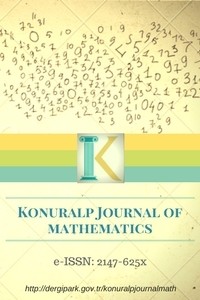On $(p,q)-$Fibonacci Polynomials Connected with Finite Operators
(p, q)−Fibonacci polynomials, Binet-like formula, generating function, finite operator, tridiagonal determinant.
On $(p,q)-$Fibonacci Polynomials Connected with Finite Operators
Binet-like formula, generating function, finite operator, tridiagonal determinant., (p, q)-Fibonacci polynomials,
___
- [1] M. Andeli´c and C. M. da Fonseca, A short proof for a determinantal formula for generalized Fibonacci numbers, Le Matematiche, 74(2), (2019), 363–367.
- [2] M. Andeli´c and C. M. da Fonseca, On a determinantal formula for derangement numbers, Kragujevac J. Math., 47(6), (2023), 847–850.
- [3] M. Andeli´c and C. M. da Fonseca, On the constant coefficients of a certain recurrence relation: A simple proof, Heliyon, 7(8), e07764, (2021). https://doi.org/10.1016/j.heliyon.2021.e07764
- [4] N. Bourbaki, Elements of Mathematics: Functions of a Real Variable: Elementary Theory (Springer, Berlin, 2004). Translated from the 1976 French original by Philip Spain. Elements of Mathematics (Berlin). https://doi.org/10.1007/978-3-642-59315-4
- [5] N. D. Cahill, J. R. D’Errico, D. A. Narayan and J. Y. Narayan, Fibonacci determinants, College Math. J., 33(3), (2002), 221–225.
- [6] M. C. Da˘glı and F. Qi, Several closed and determinantal forms for convolved Fibonacci numbers, Discrete Math. Lett., 7, (2021), 14–20.
- [7] C. M. da Fonseca, On the connection between tridiagonal matrices, Chebyshev polynomails, and Fibonacci numbers, Acta Univ. Sapientiae Math., 12, (2020), 280–286.
- [8] C. M. da Fonseca, Some comments on the properties of a particular tridiagonal matrix, J. Discret. Math. Sci. Cryptogr., 24(1), (2021), 49–51.
- [9] C. M. da Fonseca, On a closed form for derangement numbers: an elemantary proof, RACSAM, 114, Article ID:146, (2020). https://doi.org/10.1007/s13398-020-00879-3
- [10] C. M. da Fonseca, Unifying some Pell and Fibonacci identities, Appl. Math. Comput., 236, (2014), 41–42.
- [11] B.-N. Guo, E. Polatlı and F. Qi, Determinantal Formulas and Recurrent Relations for Bi-Periodic Fibonacci and Lucas Polynomials. In: Paikray S.K., Dutta H., Mordeson J.N. (eds) New Trends in Applied Analysis and Computational Mathematics. Advances in Intelligent Systems and Computing, vol 1356. Springer, Singapore. https://doi.org/10.1007/978-981-16-1402-6 18
- [12] A. F. Horadam, Extension of a synthesis for a class of polynomial sequences, Fibonacci Q., 34, (1996), 68–74.
- [13] C. Kızılates¸, B. C¸ ekim and N.Tu˘glu, T. Kim, New Families of Three-Variable Polynomials Coupled with Well-Known Polynomials and Numbers, Symmetry, 11, 264, (2019). https://doi.org/10.3390/sym11020264
- [14] C. Kızılates¸, New families of Horadam numbers associated with finite operators and their applications, Math. Methods Appl. Sci., (2021). https://doi.org/10.1002/mma.7702
- [15] C. Kızılates¸, Explicit, determinantal, recursive formulas, and generating functions of generalized Humbert–Hermite polynomials via generalized Fibonacci polynomials, Math. Methods Appl. Sci., (2023). https://doi.org/10.1002/mma.9048
- [16] C. Kızılates¸, W.-S. Du and F. Qi, Several determinantal expressions of generalized Tribonacci polynomials and sequences, Tamkang J. Math., 53, (2022). http://dx.doi.org/10.5556/j.tkjm.53.2022.3743
- [17] T. Koshy, Fibonacci and Lucas Numbers with Applications, Pure and Applied Mathematics (Wiley-Interscience, New York), (2001).
- [18] G. Lee and M. As¸c¸ı, Some Properties of the (p;q)?Fibonacci and (p;q)?Lucas Polynomials, J. Appl. Math., 2012(2012), Article ID: 264842. https://doi.org/10.1155/2012/264842
- [19] R. S. Martin and J. H. Wilkinson, Handbook series linear algebra: similarity reduction of a general matrix to Hessenberg form, Numer. Math., 12(5), (1968), 349–368. https://doi.org/10.1007/BF02161358
- [20] E. O¨ zkan and I˙. Altun, Generalized Lucas polynomials and relationships between the Fibonacci polynomials and Lucas polynomials, Commun. Algebra, 47(10), (2019), 4020–4030.
- [21] E. O¨ zkan and M. Tas¸tan, On a new family of Gauss k?Lucas numbers and their polynomials, Asian-Eur. J. Math., 14(6), (2021). https://doi.org/10.1142/S1793557121501011
- [22] F. Qi, Derivatives of tangent function and tangent numbers, Appl. Math. Comput., 268, (2015), 844–858. https://doi.org/10.1016/j.amc.2015.06.123
- [23] F. Qi, M.C. Da˘glı and W.-S. Du, Determinantal forms and recursive relations of the Delannoy two-functional sequence, Adv. Theory Nonlinear Anal. Appl., 4(3), (2020), 184–193. https://doi.org/10.31197/atnaa.772734
- [24] J. Ram´ırez, On convolved generalized Fibonacci and Lucas polynomials, Appl. Math. Comput., 229, (2014), 208–213.
- [25] A. G. Shannon, Fibonacci analogs of the classical polynomials, Math. Mag., 48(3), (1975), 123–130.
- [26] Y. S¸ims¸ek, Some new families of special polynomials and numbers associated with finite operators, Symmetry, 12(237), (2020), 1–13.
- [27] Y. S¸ims¸ek, Construction method for generating of special numbers and polynomials arising from analysis of new operators, Math. Meth. Appl. Sci., 41(16), (2018), 6934–6954.
- [28] N. Terzio˘glu, C. Kızılates¸ and W-S Du, New properties and identities for Fibonacci finite operator quaternions, Mathematics, 10(10), 1719, (2022). https://doi.org/10.3390/math10101719
- [29] J. Wang, Some new results for the (p;q)?Fibonacci and Lucas polynomials, Adv. Differ. Equ., 2014(2014), Article ID: 64.
- Yayın Aralığı: Yılda 2 Sayı
- Başlangıç: 2013
- Yayıncı: Mehmet Zeki SARIKAYA
On Hermite-Hadamard type Inequalities for Proportional Caputo-Hybrid Operator
Existence of Positive Periodic Solutions of First Order Neutral Differential Equations
Wintgen Inequalities for Submanifolds of $\delta$-Lorentzian Trans-Sasakian Space Form
On $\Gamma$-Paracompact Spaces
A Note On The Matrix Operators Of Absolute Nörlund Series Space
Properties of Double Fuzzy $b$-Open Sets
J PRINCIVISHVAMALAR, N. RAJESH, B BRUNDHA
$q$-Multiplicative Dirac System
Bilender PAŞAOĞLU, Hüseyin TUNA
Şerife Nur BOZDAĞ, Selcen YÜKSEL PERKTAŞ, Feyza Esra ERDOĞAN
On Rectifying Slant Curves in Galilean Space
Mustafa DEDE, Cumali EKİ̇Cİ̇, Mahmut KOÇAK
On Super Magic Algorithm for Union of Comb and Star Graph
Rongbing HUANG, Muhammad Farhan HANİF, Muhammad Kamran SİDDİQUİ, Muhammad Faisal NADEEM
